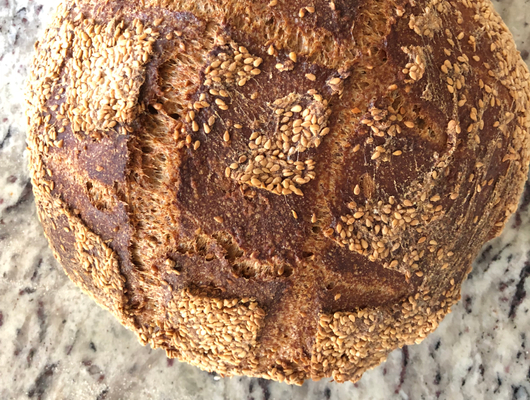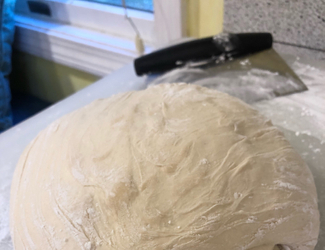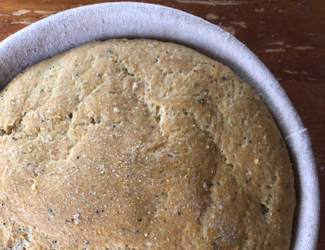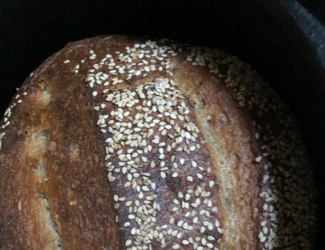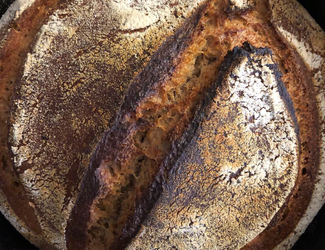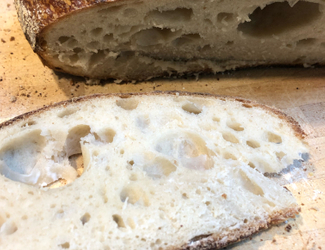SIMPLE SOURDOUGH BREAD
Making great sourdough isn’t easy, but with our help you should be able to get started making the best sourdough bread of your life!
Making the sourdough starter
Making a sourdough starter is the most trying and discouraging part of the whole process, but you have to think of the massive rewards in store for you when you inevitably succeed. To make the sourdough starter, the best thing you can do is combine two cups of warm water (85-90 degrees F; a digital thermometer helps!) with two cups of fresh whole wheat flour. I know some people swear by the use of rye flour when making sourdough starters. Rye is really cool, but I would encourage you to use whatever works. Either way, you should be mixing the flour and water recipe with you hands - this helps to inculcate the mixture with yeast cultures.
Wait 24 hours, then discard 80% of the flour / water mix and combine the last 20% with a fresh mixture of flour and water (same temp as before: 85- 90 degrees F!). You’ll be doing the same thing the next day.
By 12 hours after first having discarded the flour / water mix, there should be air bubbles on the surface of your starter-to-be. By 24 hours, you’re ready to feed the nascent sourdough starter again. Get to it by once again discarding 80% of the mix and re-adding two more cups of flour and two more cups of warm water together.
By day three, your sourdough starter should be ready to be used. It should be bubbling happily and the top of it should be an entire layer of yeast on top of the remaining flour / water mixture.
You’ll need to “feed” your starter nearly every day in order to have it ready to be used for bread at a moment’s notice. Most commercial sourdough bakeries keep their starter culture distinct from the portion of their sourdough starter that they’ll use to make bread. The starter set aside to be used in making the daily bread is referred to as the “levain” — or the leaven for the bread.
Caring for your starter
If you don’t want to feed your starter every day, you can refrigerate it! This will slow down the yeast’s consumption of the flour / water mix it uses to survive. There is a non-obvious trade-off made when refrigerating your starter, however - sourdough starters produce two different kinds of acid: acetic and lactic acid. A cooler starter will produce more acetic acid by default, and there is some evidence that suggests that the lactic acid produced by a sourdough starter is responsible for the health benefits enjoyed by consumers of sourdough; acetic acid, while responsible for the distinctly “sour” flavor that gives sourdough its name, can be overpowering in large quantities, and the baker chilling their starter should be aware that fermentation times should be abbreviated in order to prevent the resulting bread from being overly sour to the point of being unenjoyable!
If you are refrigerating your starter in order to reduce the amount of flour it needs to be fed, a common strategy is to remove it from the fridge the day before baking, and to feed it. This way it has time to warm up and, hopefully, the time to adapt to producing more lactic acid.
Making sourdough levain
If you bake every single day, you can simply use what you would discard from your starter as your levain. If you want to keep your sourdough starter separate from your levain (which will be used to make the actual sourdough you consume), you can easily make a levain separate from your starter by combining 75g of warm water with 75g of whole whole flour and a spoonful or two of your starter. In 6-12 hours (depending on heat and the overall activity level of your starter), you’ll have a levain that floats readily in water (use a spoonful to test!) and smells sweetly ripe — ready to be used to make sourdough!
Dutch Oven Sourdough
The vital importance of the dutch oven in creating home oven-baked sourdough cannot be overstated. It’s crucial that your cooker have a lid; this seals the steam escaping from the dough within the cooker and ensures that, for the first 30 minutes of the bake, the inside of the dough cooks without the outside being burned.
It is only after the interior of the dough has cooked thoroughly that the dutch oven lid should be removed so that a hearty and crisp crust can develop prior to the bake finishing.
Ingredients
- 150 g levain
- 1000 g whole wheat flour
- 800 - 1000 g warm (85-90 degree F) water
- 20 g of salt
- Cast iron dutch oven
- Digital thermometer (optional, but it really helps!)
Steps
- Mix the flour, water, and levain together
- Set a timer for thirty minutes - when it’s up, mix the 20 grams of salt into the flour / water / levain mixture
- For the next 4 hours, you’re going to fold the dough every thirty minutes. Folding the dough involves imagining the dough as a square — lightly stretching a corner of the dough over the top and repeating until the four “corners” have been stretched over one another. This should be done gently, as gas bubbles begin to build in the dough — crucial to the flavor that will later develop in the oven! If you are incorporating sprouted grains into your dough (check out our Sprouting Grains recipe for the skinny on how to do so!) you will want to incorporate the grains during the second fold, an hour into the bulk rise. We typically use up to 500 grams of sprouted grains per 1000 grams of flour.
- After the first four hours, you’re going to “bench rest” the dough by gently scooping it out of its bowl onto a lightly floured working surface. Alternatively, lightly oil the working surface. We use cutting boards, but when I had granite countertops I also liberally made use of those. Lightly flour the top of the dough and set a towel over it — set a timer for another thirty minutes. When that’s up, you’re ready to shape the dough into its final form — using oil on the working surface definitely makes this step easier as you work the dough into its final shape. You can either repeat the folding procedure that you used when the dough was in its bowl, flipping the dough over after having folded the four corners to seal the seams created by folding … or you can spread the dough out into a rectangular shape. If you do choose to spread it out into a rectangle, you will want to fold a quarter of the dough, length-wise, across itself, and do the same with the other side. You should have a thinner rectangular double decker piece of dough if you’ve done this right — now for the fun part! To finish folding the dough this way, roll the dough along its length. With either method, you’ll want to set the dough ball with the seams that you’ve made in folding the dough on the bottom so that they can seal.
- Overnight fermentation — lightly flour a towel and flip the folded dough from the working surface onto the towel. Grab the four corners of the towel and plop the now-wrapped and folded dough into a proofing bowl; it can be any old bowl, but the size is important. It should barely be large enough to hold the dough and towel. Let sit overnight in the refrigerator.
- Remove the dough from the fridge & start to pre-heat oven to 500 degrees F - put cast iron dutch oven in the oven to pre-heat at the same time
- Once oven has reached 500 degrees F, take out cast iron cooker and roll your dough out of its proofing container into your dutch oven. Score the bread with a very sharp knife - run the knife across the dough in a series of decorative lines / circles. While optional, scoring the dough helps the dough to rise uniformly by controlling where steam escapes.
- Put the top back on your dutch oven and reinsert into the oven. Bake with the lid on for 30 minutes.
- For the last 30 minutes, remove the cover and lower the temperature of your oven to 465 degrees F. Bake for 30 minutes, or until the internal temperature of the dough nears 210 degrees F. The crust should have developed a rich baked exterior during this time.
- Enjoy! It’s actually best to let the bread sit for several hours, as fresh out of the oven it will still be very moist within the interior and requires time to set. That said, there are few joys greater in life than enjoying a slice of bread hot out of the oven - you will just need an extremely sharp serrated knife to cut the new bread. Be careful, and enjoy!
Rate our recipe!
Thanks for reading our recipe and we really hope you enjoyed it! We're always happy to get feedback on the quality our recipes provided - if you liked it, make sure you click on the fifth ⭐ to give this recipe a top-notch rating.

